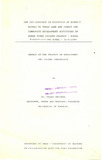| dc.description.abstract | In most Developing countries only a small number of new jobs
are available in agriculture. The capital scarcity limits the
number of nonfarm jobs that can be created, because investments
costs per job are high in modern industry. Thus an effective
development policy should seek to increase the labor relative to.,
capital, to the extent that it is economically efficient.
In the Sessional Paper No. 1 of 1986 on Economic Management
for Renewed Growth, the Kenya Government notes that
historically, there has been
continue) on the youth corning to
collar employment. The Paper
a tendency (which will obviously
urban areas seeking for white
further notes that given the
opportunities opened up by rising rural income together with
pressure for new jobs exerted by I a growing workforce that is
estimated to double from 7.5 million 1984) to 14 million by the
year 2000, informal sector (or small-scale Enterprises, SSES)
will have to expand. The formal sector is estimated to absorb
only 1.15 million (1984) to 2.33 million (2000).
Estimates show that after other employment sectors take
their potion with urban informal sector taking "from 0.2
million (1984) to 0.4 million (2000) and rural non-farm 1.31
million (1984) to 2.84 million (2000) - the unemployed will be
0.98 million (1984) and about 1.4 million to 2.85 million
(2000). These unemployed include unsurveyed urban wage workers
and casual workers as well as the unemployed. Thus it is
officially recognised that modern sector will be unable to
accommodate more than a fraction of Kenya's workers from now to
the end of the century and that the majority of the future non-
2 -
farm job opportunities will be in the informal sector (or smallscale
enterprises, SSEs).
One of the main objectives of the Third Urban Project was to
assist in the development of an integrated urban network which
will support economic growth in rural areas and improve the
population holding capacity and urban employment base of
secondary towns in Kenya. The specific objective of this section
is to evaluate employment creation by Third Urban Projects in the
selected towns of Eldoret, Nakuru and Thika both direct and
indirect. For those p.rojects already implemented we are
interested in determining the activity groups that are
successful, facing problems, and what types of problems" the
extent to which they are trying to solve these problems and how
the authorities concerned can enhance their development. Income
profiles of these activity groups and the extent to which these
projects are benefiting urban poor are determined. | en_US |



